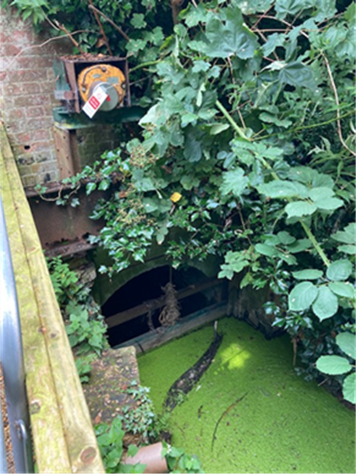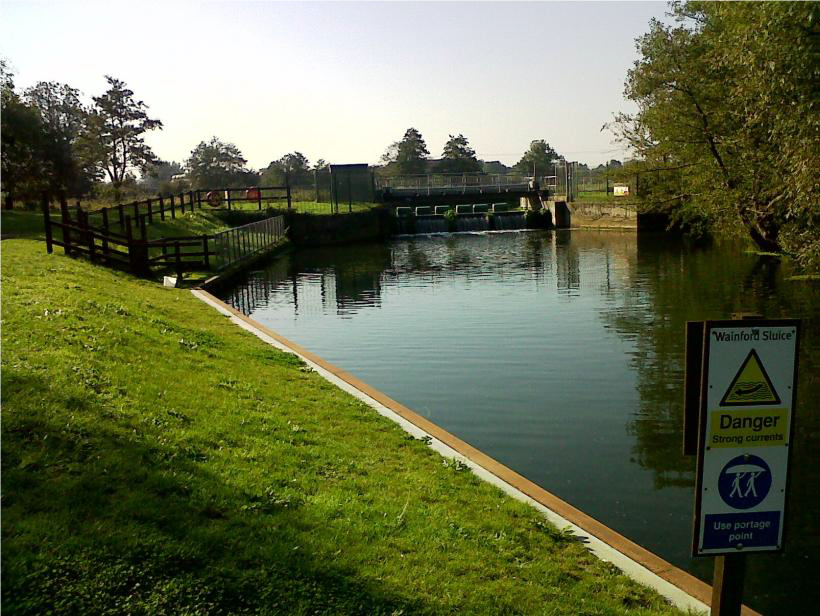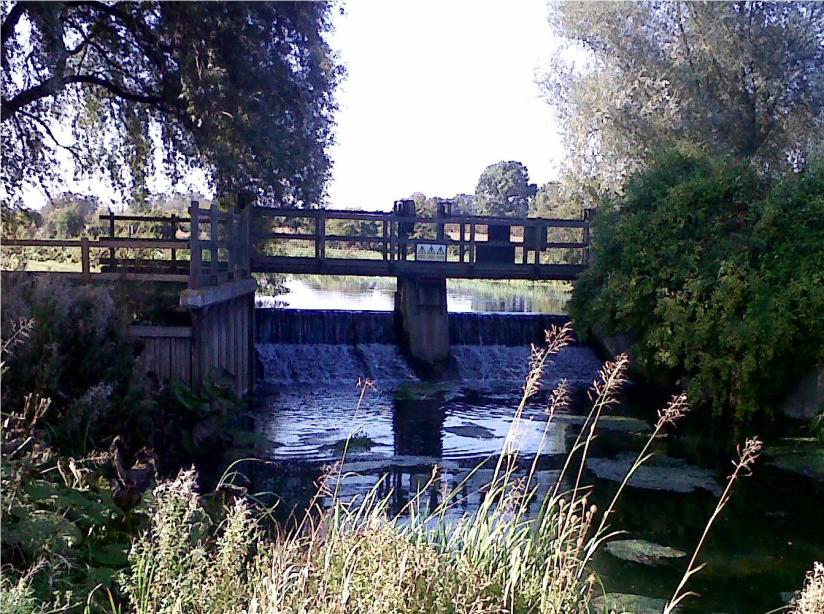Mill sluices at Wainford, Wortwell and Hoxne, River Waveney Information
Overview
Update as of 24th May 2023 - On the basis that we have not received any information that we believe would make a change in ownership or maintenance responsibility unviable, our proposal was put before the April 2023 meeting of the Anglian Eastern Regional Flood and Coastal Committee (RFCC) for their endorsement as required in our Protocol for the Maintenance of Flood and Coastal Risk Management Assets. The committee supported the proposal and therefore we will shortly be formalising our withdrawal of maintenance.
To discuss the RFCC's decision, and for all future general enquiries regarding these mill sluices, please contact Emily Eardley (emily.eardley@environment-agency.gov.uk).
--------------------------------------------------------------------------------------------
Between Friday 15th October and Friday 12th November 2021, the Environment Agency undertook an initial consultation period regarding our proposal to withdraw our maintenance responsibility for three mill sluices at Hoxne, Wainford and Wortwell on the River Waveney. At Hoxne and Wainford, this also includes the transferal of the rights and responsibilities for these structures to third party riparian owners.
The initial consultation period was the first and crucial step in capturing public views. We have not withdrawn our maintenance responsibility and transferred the rights and responsibilities for these structures to third parties already. In addition, no final decision has been made regarding our proposal.
The comments and questions that were submitted during the initial consultation period have been reviewed to re-assess the viability of our proposal and inform the next stages in the engagement process.
This web page has been created to provide more information on our proposal and address any concerns that you may have.
The information on the web page itself addresses the key questions that relate to our proposal. In addition, the Frequently Asked Questions (FAQ) documents at the bottom of the web page have been created to address the other questions and comments we received.
Which structures are we proposing to withdraw our maintenance responsibility for and transfer ownership to third party riparian owners?
Wainford
The structure at Wainford that we are proposing to withdraw our maintenance responsibility for and transfer ownership to a third party riparian owner is the mill sluice within the curtilage of the mill building located at national grid reference TM3507690085.

Photograph 1: Environment Agency owned and maintained mill sluice at Wainford Mill.
The Wainford Site Plan shows the location of this mill sluice within the mill race. It is behind a high brick wall adjacent to Pirnhow Street and is not visible from the road.
We are not proposing to withdraw our maintenance responsibility for the main Wainford Sluice located at national grid reference TM3497890094 nor are we transferring the rights and responsibilities for this structure to a third party riparian owner. The Environment Agency will continue to own, operate and maintain this larger sluice.
 Photograph 2: Environment Agency owned, operated and maintained Wainford Sluice. We are not proposing to withdraw our maintenance responsibility for this asset nor are we transferring the rights and responsibilities for this structure to a third party riparian owner.
Photograph 2: Environment Agency owned, operated and maintained Wainford Sluice. We are not proposing to withdraw our maintenance responsibility for this asset nor are we transferring the rights and responsibilities for this structure to a third party riparian owner.
Source: River Waveney Control Structures Report
Wortwell
The structure at Wortwell that we are proposing to withdraw our maintenance responsibility for is the mill sluice within the curtilage of the mill building located at national grid reference TM2816284464.
 Photograph 3: Environment Agency maintained mill sluice at Wortwell Mill
Photograph 3: Environment Agency maintained mill sluice at Wortwell Mill
The Wortwell Site Plan shows the location of this mill sluice. It is just upstream of the mill and within the mill race.
We are not proposing to withdraw our maintenance responsibility for the main Wortwell Sluice located at national grid reference TM 28099 84430 nor are we transferring the rights and responsibilities for this structure to a third party riparian owner.
The Environment Agency will continue to own, operate and maintain this larger river control structure. This will mean that our staff will continue to visit the site to manually adjust the gates to manage water levels.
 Photograph 4: Environment Agency owned, operated and maintained Wortwell Sluice. We are not proposing to withdraw our maintenance responsibility for this asset nor are we transferring the rights and responsibilities for this structure to a third party riparian owner.
Photograph 4: Environment Agency owned, operated and maintained Wortwell Sluice. We are not proposing to withdraw our maintenance responsibility for this asset nor are we transferring the rights and responsibilities for this structure to a third party riparian owner.
Source: River Waveney Control Structures Report
Hoxne
The structure at Hoxne that we are proposing to withdraw our maintenance responsibility for and transfer ownership to a third party riparian owner is the mill sluice within the curtilage of the mill building located at national grid reference TM1888777839.

Photograph 5: Environment Agency owned, operated and maintained Hoxne Sluice.
The Hoxne Mill Site Plan shows the location of this sluice. It is approximately 70m upstream of the mill, located on the left hand bank of the mill race.
Why is the Environment Agency considering withdrawing their maintenance responsibility for these structures and transferring ownership to third party riparian owners?
Between 2015 and 2020, we planned to spend over £1 billion on maintaining flood risk management assets. This is compared to the £812 million that was spent in the previous five years. This includes spending on maintenance work such as inspecting assets and carrying out repairs.
We recognise the devastating impact that the 2020 flooding had on people, homes and communities across the River Waveney catchment. As part of our recovery work, we are reviewing how we undertake channel and mill sluice maintenance along this watercourse, and the role that all of the structures play in reducing flood risk to people and properties.
We have permissive powers to carry out flood risk management works on designated main rivers, but no legal obligation to do so. Consequently, we can stop maintaining and operating assets if the cost is judged to outweigh the benefits. Such decisions will be informed, for example, by government policy and assessments of flood risk, funding or environmental priorities.
In addition, we are required to spend flood risk management funding within the financial guidelines set out by Defra and on works that have a demonstrable benefit in reducing flood risk to people and property (i.e. homes and businesses with a postcode). If the Mill Sluices at Wainford, Wortwell and Hoxne were not currently in place, we would not build a structure in these locations to protect people and property from flooding. As a result, continuing to maintain these structures that are not key assets in managing flood risk does not allow us to focus our resources where they are most needed and spend public money responsibly by investing in those activities that contribute most to reducing flood risk.
In the context of these mill sluices that are associated with managing water levels for the mills and for agricultural purposes, transferring maintenance responsibility and ownership to third parties will allow us to manage flood risk to people and property across the River Waveney catchment in the most efficient and effective way
Is there any modelling in place that supports the idea that these mill sluices are not key assets in managing flood risk?
In 2012 a report was commissioned to model the influence of removing several structures along the River Waveney. This was done to help develop our understanding of how these structures impact flood risk.
The structures were modelled as removed because at the time, this was seen as the scenario that could have the greatest impact on flood risk to people and property.
The findings from these 2012 modelling reports for the structures at Wainford, Wortwell and Hoxne can be found at the bottom of our web page in the summary modelling reports.
If the water levels and flood extents do not change significantly when a structure is modelled as removed, this shows that the structure does not provide additional protection to people and property when compared to the natural river channel and is therefore not a key asset in managing flood risk to people and property. This is the case for the structures modelled at these three locations.
Despite this, in April 2022 we commissioned further hydraulic modelling that focused specifically on the mill sluices at Wainford, Wortwell and Hoxne to provide more information on the flood risk to people and property if these assets were left closed during a flood event.
The findings from this modelling report can also be found at the bottom of this webpage in the 'Related Docs' section.
On the basis that there are minimal changes to flood extents, flood depths and in-channel water levels for the range of flood events modelled, and no additional properties are found to flood, the position of the gate(s) for these assets has minimal impact on flood risk.
Therefore along with the main sluices, these structures do not provide additional protection to people and property when compared to the natural river channel and are not key assets in managing flood risk to people and property.
How, although these mill sluices are primarily used to manage water levels, are they not key assets in managing flood risk?
The numerous sluices along the River Waveney were originally constructed to maintain upstream water levels for the mills and for agricultural purposes. This was particularly important in the summer months with lower rainfall resulting in lower flow in the channel. Today, this water level management provides other benefits including landscape aesthetics as well as recreational opportunities through activities such as canoeing.
As a result, the mill sluices at Wainford, Wortwell and Hoxne are all considered water level management structures because they are located in mill races and were specifically used to control the flow of water to the mills. At Wainford and Wortwell, the main sluices now re-route the majority of the river flow around the mill complexes. At Hoxne, the weir upstream of the mill has a similar effect on river flow.
In addition, these mill sluices were never built to protect properties from flooding. Given the location and size of these structures, they do not hold back sufficient water when closed to reduce flood risk to people and property downstream, nor do they allow sufficient water to flow downstream when fully opened to reduce flood risk upstream.
What measures are in place to ensure that any new owner/operator manages water levels in the public interest?
Whilst these mill sluices are not key assets in managing flood risk, we do recognise that they are important in terms of managing water levels, particularly for agricultural purposes.
The rights and responsibilities of a riparian owner have been established in common law for many years. For example, a riparian owner must let water flow through their land without any obstruction or diversion which affects the rights of others. Others have the right to receive water in its natural quantity and quality and therefore this means that water should not be taken out of a watercourse if it could lead to a lack of water for those who need it downstream. These rights and responsibilities apply to all riparian owners and therefore whilst any new owner/operator can manage water levels differently to how they have been managed in the past, they cannot do so in such a way that negatively impacts others.
Whilst some landowners would rather see water levels controlled by an independent body such as the Environment Agency, there are a number of measures in place to ensure that future water level management does not negatively impact landowners if a small number of mill sluices are transferred to private owners.
The informal conversations that have taken place between the Environment Agency and the prospective new owners indicate that they wish to maintain the current situation with regards to water levels to prevent negative impacts on neighbouring landowners.
In addition, the comments we have received from members of the public will allow us to understand the specific impacts that a change in water level could have on other landowners. This feedback will be shared with any potential new owner/operator prior to the transfer of rights and responsibilities to ensure that they understand how the operation of the structure could impact other riparian owners.
Lastly, any new owner/operator will be made aware of their riparian rights and responsibilities along with their legal obligations under the Anglian Region Land Drainage and Sea Defence Byelaws, which are enforced in accordance with the Water Resources Act 1991, and Environmental Permitting (England and Wales) Regulations 2016 if the process goes ahead.
What happens next?
It is important to note that we have not already withdrawn our maintenance responsibility and/or transferred the rights and responsibilities for these mill sluices to any third parties. In addition, no final decision has been made regarding our proposal.
We plan to submit our proposal to the Regional Flood and Coastal Committee (RFCC) at the end of April 2023 for approval.
If our proposal is approved and we do withdraw our maintainance responsibilities, we will continue to maintain the mill sluices throughout any notice period. At the end of the notice period we will cease all maintenance. Decisions about future maintenance will be for any new owner/operator to make from that point onwards.
Audiences
- Members of the public
Interests
- Flood management

Share
Share on Twitter Share on Facebook